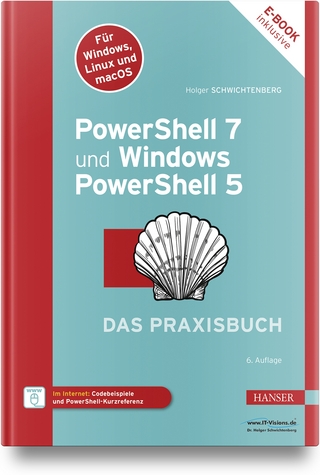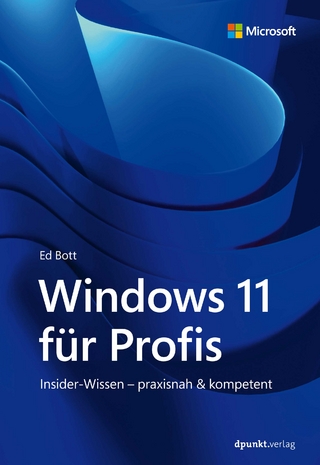
NT Server
Prentice Hall (Verlag)
978-0-13-107046-2 (ISBN)
- Titel erscheint in neuer Auflage
- Artikel merken
Written for anyone who has the responsibility for managing or installing NT server 3.5, this book contains many step-by-step instructions for controlling a NT Server network. The book covers Windows for workgroups configurations, systems management server, trouble-shooting, hardware selections, and third-party product selection.
1. Installation of NT Server. General Installation Tips. Basic Information Before You Install. Potential Problems with SCSI Disks and Controllers. What Type of Volume Do I Use for NT System Files? How NT Handles Installation Media. Installation Methods. Express Versus Custom. Standard Installation. Reinstalling NT. Automating the Configuration of a New Server. Upgrading an Existing Installation of NT. 2. Server Configuration and Management. Overview of Managing NT Servers. Introduction to the NT Resource Kit Utilities. Using Programs from the NT Resource Kit. Command Prompt Operations. Batch Programs. The Registry Database. Editing the Registry Manually with REGEDT32. Editing the Registry with RegKey (NT Resource Kit). NT Server License Management. Managing Disk Systems. Disk Systems and NT. Creating and Deleting Partitions. Formatting a Partition. Labeling a Volume. Assigning Drive Letters to a Volume. Saving Disk Configuration Information. Disk Fault Tolerance 2.6.8 Converting a FAT or HPFS Partition to NTFS. Adding Disks. Applications and Stripe Sets. Device Drivers. Services. Managing Services. Symmetrical MultiProcessor (SMP) Configurations. Control Panel. Removing NT Components to Save Space. Starting a Server. Stopping a Server. Configuring Automatic Logon for NT Server. Changing the Logon Wallpaper for NT Server (and Why?). Connecting to Another System Using IPC$. Management from an NT Workstation. Management from Windows 3.x and Windows 95 Systems. System Alerts. Event Logging. Overview. Event Viewer. DumpEL (NT Resource Kit). Configuring Automatic Restart of a Server. Repairing Damaged System Files. BOOT.INI Options. Adding a Second Boot Option for NT. BOOT.INI Options for UPS and Other Hardware Devices. Stopping an Application on the Server. NT Error and Informational Messages. Microsoft Diagnostics (WINMSD). Using Multiple Servers with a Single Keyboard/Mouse/Monitor. Designing a System for Performance. Server Types. Fast Processor with 256K or Greater CACHE. Lots of Memory. Network Cards. Video Systems. Disk Drives and Controllers. Configuration Issues. Hardware Notes. Typical Hardware Problems. Preventing Hardware Nightmares. General Hardware Notes. Digital Equipment Corporation. Compaq Proliant. Dell and HP. Disk Drives. SCSI Devices. Serial Communications. Changing Hardware. Hardware Issues on Performance. Technical Support for Your System. 3. Network Configuration and Management. Network Administration Group (in Program Manager). Network Client Administrator. DHCP Manager. WINS Manager. Telnet and Terminal. Network Topologies Supported. Protocols and Related Stuff. NetBEUI. NBF. TCP/IP. SMB. DLC. NWLINK, IPX/SPX, and Other NetWare Stuff. AppleTalk and EtherTalk. Choosing a Protocol. Installing or Changing Protocols and Other Network Items. General Overview. The Optimal Protocol Choice Multiple Protocols. Troubleshooting Programs for TCP/IP. Verifying Connections with PING. Checking Your DHCP Configuration with IPCONFIG. Configuring Browsing on Your Network. Browsemasters and Such. Browsing Other Domains. Monitoring Browsers. Shared Resources. Special Shares. Monitoring Shared Resources. Domain Overview. 3.10.1 Primary Domain Controller. Backup Domain Controllers. Domain Models. Single Domain Model. Master Domain Model. Multiple Master Domain Model. Complete Trust Model. Roll Your Own Model. Domains and Systems Management Server. Domain, Server, User Account, and Group Names and Tips. Domain Names. Computer Names. Hints for Managing Your Domain. Registry Size and Domains. Adding or Removing an NT Workstation or NT Server in a Domain. Changing Domains with a Server Not! Synchronizing Domain Controllers. Promoting a Backup Domain Controller to a Primary Domain Controller. Stopping the Primary Domain Controller. Logging on to a Backup Domain Controller. Trust Relationships. Using Trust Relationships. Designing Network Servers. Computer Names and NT Server. Multiple Network Interface Cards in One Server. Mixed Language Networks. Coexistence of Windows NT Server with Other Networks. LAN Manager 2.x Servers. Pathworks 5.x. Gateway Services for NetWare. Setting the Search Order for Multiple Network Providers. Binding Network Components. Optimizing Memory Utilization on a Server. Remote Access Service. Design and Configuration. Installing RAS. Assigning RAS Permissions to Users. Managing the RAS System. Miscellaneous Notes. Accessing an RAS Server and Guest Accounts. RAS with Windows for Workgroups and Windows 95. OS/2 RAS Servers. Net2Com. Replication of Files to Other Systems. Miscellaneous Notes on Replication. Replication Between NT Server and OS/2 Servers. Software Metering and Inventory. NET Programs. NET CONFIG. NET ACCOUNTS. Synchronizing Time Across a Network with NET TIME. Synchronizing Time Across a Network with Visual Basic. Synchronizing NT Time with TimeServ (NT Resource Kit). Sending Messages to Users on a Server. 4. User Management. Domain User Accounts. What Is a Domain User Account? Modifying, Creating, Deleting, and Copying User Accounts. Account Templates. Sorting User Accounts. Controlling Which Workstations a User May Use to Log On. Controlling Logon Times. Locking Out an Account. Disabling the Default User Name in the Logon Dialog Box. Disabling and Renaming User Accounts. Restricting an Account for Local Use. Tips. Special User Accounts. User Profiles. Overview of User Profiles. Potential Problems with Profiles. Types of Profiles. Creating and Assigning Profiles. Controlling Network Connections with Profiles. Storage of Profiles. Logon Script. Client Participation with Logon and Startup Scripts. Groups. Local Groups. Special Groups. Global Groups. Managing Groups. Logging In from Multiple Workstations. Changing Passwords from an OS/2 Server. 5. File Systems. Overview. NT File Types. NT File Systems in General. NTFS. FAT. HPFS. Suggested Directory Structures. USERS Directory. Home Directory. Data Directories. Executable Programs. Sharing Directories. Connecting to NT Server Resources. Converting File Systems. Managing File Systems. Compressing Files and Directories (3.51). The Repair Disk. Duplicate NT System Files. Replacing a System File. Finding Problems with CHKDSK. Defragmenting a Disk. 6. Client Configuration and Management. Clients and Client Tools Included with NT Server. Using the Client Tools. Sharing the Client Directory. Making an Installation Boot Disk. Using the Installation Boot Disk. Installing Server Tools. Configuring Client Workstations. Common Features for Clients. NT Workstations. Windows 95. Windows for Workgroups. Workgroup Add-On for MS-DOS and MS Client. Remote Boot Option for Clients. Adding NT Workstations to a Domain. Logging On to a Domain. NT Workstation. Windows for Workgroups. Windows 95. Logon Scripts. Tracking Network Events on Clients. Windows for Workgroups 3.11. Windows 95. 7. Services for Macintosh. Overview. Services for Macintosh Network Topologies. Components of Services for Macintosh. Requirements for Services for Macintosh. Requirements for Macintosh Systems Connecting to Services for Macintosh. Security. File Server Access from Macintosh Clients. Installing and Removing Services for Macintosh. Installing Services for Macintosh. Installing the Services for Macintosh Workstation Programs. Removing Services for Macintosh. Administration of Services for Macintosh. Configuring the AppleTalk Protocol. Administering Macintosh Users. Potential Problems with Services for Macintosh. Macintosh Path Lengths. File System Issues for Services for Macintosh. Making Shared Directories Available to Macintosh Users. Disappearing Icons. Drop Folders. Macintosh Files. File and Folder Permissions. Mac and NTFS File and Directory Properties. Copying a Macintosh File to a FAT Volume. Printing with Services for Macintosh. Captured Printers. 8. Printer Use and Management. Architecture. Print Manager. Printer Security. Installing and Configuring Printers. Changing Printer Properties. Installing and Changing Drivers. Other Properties. Sharing and Unsharing a Printer. Deleting Printers. Connecting and Disconnecting to Printers. Using Multiple Printers Connected to One Print Device. Printer Pools. Considerations for Special Printers. Direct Network Interface Printers. DLC Printers. TCP/IP Printers. PostScript Printer Characteristics. Separator Pages. Printer Messages. Printing from an NT System to a Remote NT Printer. Printers on Non-NT Systems. Using Printers from Network Clients. Workgroup Add-On for MS-DOS and MS Client. Windows for Workgroups. Windows 95. Non-NT Print Servers. Windows for Workgroups. Workgroup Add-On for MS-DOS. NetWare Printers. 9. Disaster Preparedness and Management. Maintaining Tape Devices. Tape Backup Programs. NT Backup Program. Using NTBackup with the NT Scheduler. Other Backup Options. Picking the Files to Back Up. Other Files. Backup Tapes. Restoring the System Files (Registry). Backing Up Network Systems. Real-Time Backup of Server. Octopus. Real-Time Fault Tolerance with Clusters. Power Backup and Monitoring Systems. APC Power Chute. 10. Tuning NT Servers and Networks. Tuning Overview. NT Performance Monitoring System. 10.2.1 Objects and Counters. Producing a List of Performance Monitor Counters. Performance Monitor. General Performance Monitor Tips. Setting Alerts with Performance Monitor. NT Resource Kit. Automating Performance Monitor with DataLog (NT Resource Kit). Automating GUI Operations. Monitoring Performance. Bottlenecks and Other Problems. Creating an Overview Performance Monitor Settings File. Steps for Tuning. Monitoring and Controlling Server Usage. Collecting Statistics with NET STATISTICS. Domains. Processes. SNMP Management. Network Monitor (Microsoft). Tuning Specific NT Subsystems. Virtual Memory System. System Memory (RAM). Balancing the System Loading. Network Performance. CPU. Disk Subsystems. 11. Security. Security Concepts. Overview. Validation of Logons. Security Account Manager. Security and RAS. Access to Server Administrative Functions. Permissions. Securing NT System Files. Securing Floppy Disk Drives on a Server. File Deletions. Computer Accounts. Domains and Trust Accounts. Guest Accounts. Auditing. Rights. SNMP and Security. Passwords. Password Tips. Changing Passwords. Logon Restrictions. Warning Messages at Logon. Restricting Access to Certain Programs. Automatic NT Logoff. Using Profiles for Restricting Users. Starting a Screen Saver Before Logon. File and Print Resource Permissions. Finding a User Permissions with PERMS.EXE (ResKit). Hidden Shares. Client Security Issues. Windows for Workgroups. Windows 95. Appendix A. List of Products and Companies. Appendix B. Glossary of Terms and Definitions. Appendix C. Contacting the Author. Index.
| Erscheint lt. Verlag | 17.10.1995 |
|---|---|
| Verlagsort | Upper Saddle River |
| Sprache | englisch |
| Maße | 178 x 235 mm |
| Gewicht | 780 g |
| Themenwelt | Informatik ► Betriebssysteme / Server ► Windows |
| Informatik ► Betriebssysteme / Server ► Windows Server | |
| Mathematik / Informatik ► Informatik ► Netzwerke | |
| ISBN-10 | 0-13-107046-0 / 0131070460 |
| ISBN-13 | 978-0-13-107046-2 / 9780131070462 |
| Zustand | Neuware |
| Haben Sie eine Frage zum Produkt? |
aus dem Bereich



